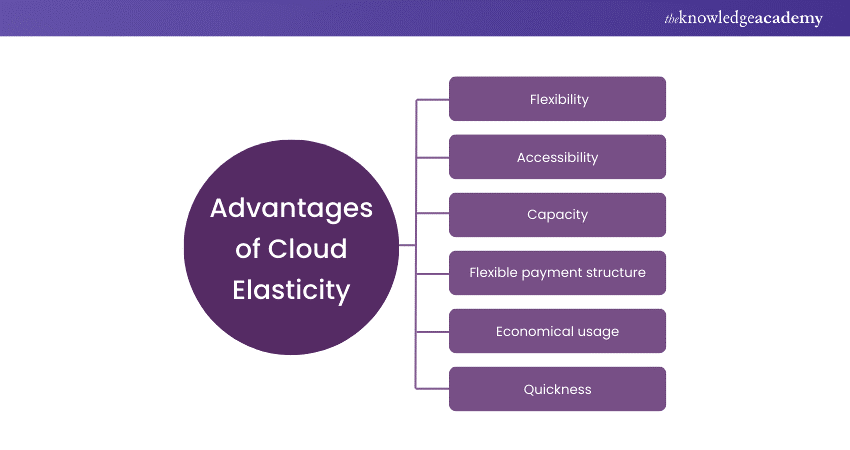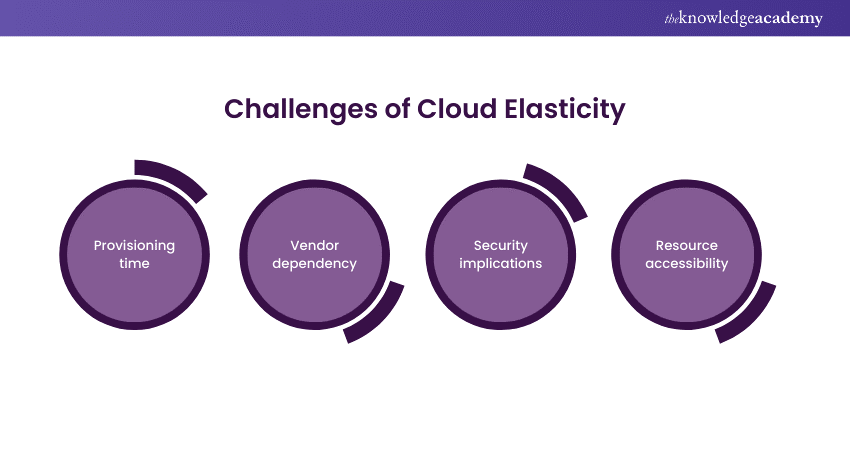We may not have the course you’re looking for. If you enquire or give us a call on +44 1344 203 999 and speak to our training experts, we may still be able to help with your training requirements.
Training Outcomes Within Your Budget!
We ensure quality, budget-alignment, and timely delivery by our expert instructors.

Imagine an E-commerce site handling a sudden surge in traffic during a sale—Cloud Elasticity ensures it runs smoothly without over-provisioning resources. But how does this differ from scalability? Worry not; Cloud Elasticity is here to the rescue. But What is Cloud Elasticity exactly?
Cloud Elasticity allows systems to dynamically scale resources up or down based on real-time needs, ensuring efficiency and cost-effectiveness. Want to learn more? Dive into this blog to explore What is Cloud Elasticity and how it can transform your business operations. Understanding Cloud Elasticity is key to staying ahead in the digital age.
Table of Contents
1) What is Cloud Elasticity?
2) How is it Different from Cloud Scalability?
3) How does Cloud Elasticity function?
4) Elements of Cloud Elasticity
5) Advantages of Cloud Elasticity
6) Challenges in Cloud Elasticity
7) Use Cases of Cloud Elasticity
8) Conclusion
What is Cloud Elasticity?
Cloud Elasticity is the capability of a Cloud to expand or contract capacity for CPU, memory, and storage resources in response to the evolving demands of an organisation. It can occur automatically, without the need for advanced capacity planning, or it can be a manual process where the organisation receives notifications about low resources and can then decide to add or reduce capacity as needed.
Monitoring tools provided by the Cloud provider dynamically adjust the allocated resources for an organisation without affecting existing Cloud-based operations.
A Cloud provider is considered to have Elasticity depending on its ability to adapt to changes in workload by autonomously provisioning or de-provisioning resources to match demand closely.
This eliminates the necessity for IT administration staff to monitor resources to determine if additional CPU, memory, or storage resources are required or if excess capacity can be decommissioned.
How is it Different From Cloud Scalability?
Cloud Elasticity and cloud scalability are closely related concepts but serve different purposes in cloud computing.
Cloud Elasticity refers to the ability of a cloud system to automatically adjust resources—such as CPU, memory, and storage—in response to changing demands. This dynamic adjustment allows organisations to efficiently manage fluctuating workloads, scaling resources up or down as needed without manual intervention.
Elasticity is particularly useful in environments where demand is unpredictable. It ensures optimal performance while minimising costs by only using resources when required.
On the other hand, Cloud scalability is about the system’s capacity to handle growth by adding more resources (vertical scaling) or increasing the number of resource units (horizontal scaling).
Scalability is a more static process that enables a cloud system to grow in response to increased load or usage over time.
Moreover, unlike elasticity, scalability does not automatically adjust resources in real-time but instead provides a framework for handling larger volumes as the organisation’s needs expand.
Understand the fundamental elements of Cloud Computing with Cloud Computing Training and acquire knowledge of how to manage virtual machines
How Does Cloud Elasticity Function?
Cloud Elasticity allows cloud resources to automatically or manually scale up or down in response to changing demands. Here's how it functions:
a) Monitoring: Cloud Computing Platforms continuously monitor resource usage, such as CPU, memory, and network traffic.
b) Automatic Scaling: When usage exceeds predefined thresholds, the system automatically scales out by adding resources or scales in by reducing them as demand drops.
c) Manual Scaling: Administrators can manually adjust resources in anticipation of known demand changes.
d) Cloud Bursting: Temporary expansion from on-premises infrastructure to the cloud during peak demand ensures seamless service.
e) Cost Efficiency: Resources are scaled back when not needed, ensuring organisations only pay for what they use.
f) Resilience: Elasticity contributes to fault tolerance by dynamically adjusting resources to handle unexpected traffic spikes or failures.
In essence, Cloud Elasticity ensures optimal resource allocation, cost efficiency, and consistent performance without the need for extensive on-premises infrastructure.
Enhance your Linux OpenStack skills with Linux OpenStack Administration Training- register today!
Advantages of Cloud Elasticity
Cloud Elasticity is more than just a technical feature—it's the cornerstone of a responsive, efficient, and cost-effective cloud strategy. The following are the advantages of Cloud Elasticity:

a) Flexibility: Cloud Elasticity eliminates the need to anticipate unforeseen demand spikes by purchasing, configuring, and installing new infrastructure when demand changes. This enables enterprises to respond to unexpected demand, such as seasonal spikes, without extensive planning.
b) Accessibility: Cloud Elasticity allows high availability and fault tolerance, as Virtual Machines (VMs) or containers can be replicated in case of malfunctions. This ensures uninterrupted business services and prevents downtime. Users can have a consistent experience even when resources are automatically provisioned or de-provisioned without disrupting operations.
Organisations can easily benefit from fault tolerance and high availability for their infrastructure and applications with Cloud Elasticity. It is possible to automatically clone servers nearing failure to minimise downtime.
Cloud services provide seamless and always available file access. Various options for accessing and modifying Data, along with alternative backups, reduce the risk of system failure.
c) Capacity: Businesses can utilise elastic Cloud computing to access an unlimited amount of storage, which is virtually accessible to anyone on the network at any time.
d) Flexible Payment Structure: A key factor contributing to the increasing popularity and rapid adoption of elastic Cloud computing is its appealing pay-for-what-you-use feature. Unlike on-premises computing, where you pay a fixed amount regardless of resource usage, elastic computing allows you to pay only for the resources you use.
e) Economical Usage: With elastic computing, businesses can avoid the high expenditures associated with expanding their data centres. Thanks to elastic computing, there is no need for additional expenses for unused capacity.
f) Quickness: The days of adding more servers to infrastructure to handle spikes in website traffic or bandwidth usage are long gone. The challenge with this approach often involved meticulous capacity planning months in advance and incurring high upfront expenses for purchasing and configuring technology.
Lead the future of software development with Microservices Architecture Training - join today!
Challenges in Cloud Elasticity
Cloud Elasticity proves beneficial primarily for organisations facing rapid or periodic fluctuations in demand for IT services. Conversely, those with consistent, predictable demand are less likely to derive advantages from Cloud Elasticity. Below listed are the several potential challenges associated with this concept:

1) Provisioning Time
While Cloud Virtual Machines (VMs) can be initiated on demand, there may be several minutes delay before they become available for use. Depending on specific application or service demands, this timeframe may or may not be sufficient, potentially impacting performance during sudden surges, such as sign-on storms at the start of the business day.
2) Vendor Dependency
Although major public Cloud providers offer Cloud Elasticity solutions, each implements them differently. This implies that organisations might become locked into a single vendor for their Cloud requirements.
3) Security Implications
While Cloud Virtual Machines (VMs) can be initiated on demand, there may be several minutes delay before they become available for use. Depending on specific application or service demands, this timeframe may or may not be sufficient, potentially impacting performance during sudden surges, such as sign-on storms at the start of the business day.
4) Resource Accessibility
Implementing Cloud Elasticity requires adjustments to existing Cloud or on-premises deployments. Organisations managing their IT internally must acquire technical expertise, including architects, developers, and administrators, to ensure that the Cloud Elasticity plan is configured to meet specific organisational needs. This may introduce a learning curve delay as newly acquired talent familiarises themselves with new environments, languages, and the automation tools and processes that need implementation.
Use Cases of Cloud Elasticity
Cloud Elasticity is both a theoretical and practical solution to drive real-world efficiency across various industries. By allowing resources to scale dynamically, it empowers businesses to handle fluctuating demands with precision and agility. Below listed are some of the use cases of Cloud Elasticity:
1) Online Retail Business
Events on e-commerce websites, such as sales, promotions, and the launch of unique products, attract significantly more visitors than usual. Cloud Elasticity enables these websites to efficiently allocate resources during periods of high demand, ensuring customers can complete their purchases.
Customers may engage in multiple activities simultaneously, such as searching for products, adding items to their carts, making purchases, paying for them, reading reviews, and more. Undoubtedly, this increases server load and traffic. With elastic computing, you can scale up your application resources to meet user demand during busy festival seasons. Post-sale, you can relinquish the excess capacity to your Cloud service provider, maintaining only what is necessary for ongoing business operations.
2) Web-based Reservation Platforms
Imagine a popular band or artist performing in your city. The mention of this musician or group will fuel the desire of their fans to secure tickets for the live performance. The increased traffic on the booking app is likely to strain the servers, potentially causing delays in processing tickets or even a complete crash. Elasticity eliminates concerns about these issues.
3) Streaming Platforms
Streaming platforms need to effectively handle events like the release of a highly anticipated album or TV show. For instance, Netflix claims it can rapidly deploy "thousands of virtual servers and petabytes of storage" on AWS's elastic Cloud services. This ensures consumers can enjoy their preferred content seamlessly, regardless of concurrent viewership.
Netflix engineers consistently highlight the use of AWS's elastic Cloud services to manage high volumes of server requests swiftly and without downtime. The addition of extra resources can handle both unexpected and anticipated surges in traffic, allowing millions of people to stream their favourite shows simultaneously.
4) Automobile Insurance Services
If you work in the vehicle insurance industry, imagine clients renewing their auto insurance around the same time each year. Anticipate a spike in traffic during this period as policyholders rush to meet the renewal deadline. Relying solely on scalability could lead to service interruptions if the traffic surge surpasses the allocated virtual machine.
However, by "leasing" additional virtual computers, you can effectively manage the increased traffic throughout the policy renewal period. This real-time demand control, facilitated by several expandable virtual machines, ensures a seamless experience for policyholders. Whether you served more clients this year than last, policyholders wouldn't detect any differences in performance. Once the off-peak season arrives, you can release the unused virtual computers.
Automate your AWS infrastructure with Terraform Training- join today!
Conclusion
The adaptability and accessibility of your company significantly influence your capacity to dynamically oversee resources during peak periods and allocate them as required. Numerous enterprises have transitioned entirely or partially to Cloud service providers or shifted specific IT workloads to Cloud platforms. We hope you find this blog informative and meaningful on the blog on What is Cloud Elasticity and related insights.
Build intelligent Cloud Applications with Certified Artificial Intelligence (AI) For Cloud Professionals Training- sign up today!
Frequently Asked Questions

Organisations can ensure effective Cloud Elasticity by leveraging auto-scaling features, monitoring resource usage in real-time, and optimising workloads. This approach allows for automatic adjustments in computing resources, providing performance and cost-efficiency even during fluctuating demand.

Future trends in Cloud Elasticity include AI-driven automation, predictive scaling, edge computing integration, and enhanced multi-cloud support. These advancements aim to optimise resource allocation, reduce latency, and improve overall efficiency in handling dynamic workloads.

The Knowledge Academy takes global learning to new heights, offering over 30,000 online courses across 490+ locations in 220 countries. This expansive reach ensures accessibility and convenience for learners worldwide.
Alongside our diverse Online Course Catalogue, encompassing 17 major categories, we go the extra mile by providing a plethora of free educational Online Resources like News updates, blogs, videos, webinars, and interview questions. Tailoring learning experiences further, professionals can maximise value with customisable Course Bundles of TKA.

The Knowledge Academy’s Knowledge Pass, a prepaid voucher, adds another layer of flexibility, allowing course bookings over a 12-month period. Join us on a journey where education knows no bounds.

The Knowledge Academy offers various Cloud Computing courses, including the Linux OpenStack Administration Training, Microservices Architecture Training, and Terraform Training. These courses cater to different skill levels, providing comprehensive insights into Cloud Formation vs Terraform: A Detailed Comparison.
Our Cloud Computing Blogs covers a range of topics related to PRINCE2, offering valuable resources, best practices, and industry insights. Whether you are a beginner or looking to advance your Project Management skills, The Knowledge Academy's diverse courses and informative blogs have you covered.

The Knowledge Academy’s FlexiPass is a pre-paid training voucher that is built specifically for clients and their dynamic needs. It provides access to a wide range of courses, at a pre-determined price, with robust safety measures. FlexiPass gives clients the added benefit of upskilling on a budget that best fits them.
Upcoming Cloud Computing Resources Batches & Dates
Date
 Cloud Computing Training
Cloud Computing Training
Thu 5th Dec 2024
Thu 13th Feb 2025
Thu 10th Apr 2025
Thu 12th Jun 2025
Thu 14th Aug 2025
Thu 9th Oct 2025
Thu 11th Dec 2025







 Top Rated Course
Top Rated Course



 If you wish to make any changes to your course, please
If you wish to make any changes to your course, please


